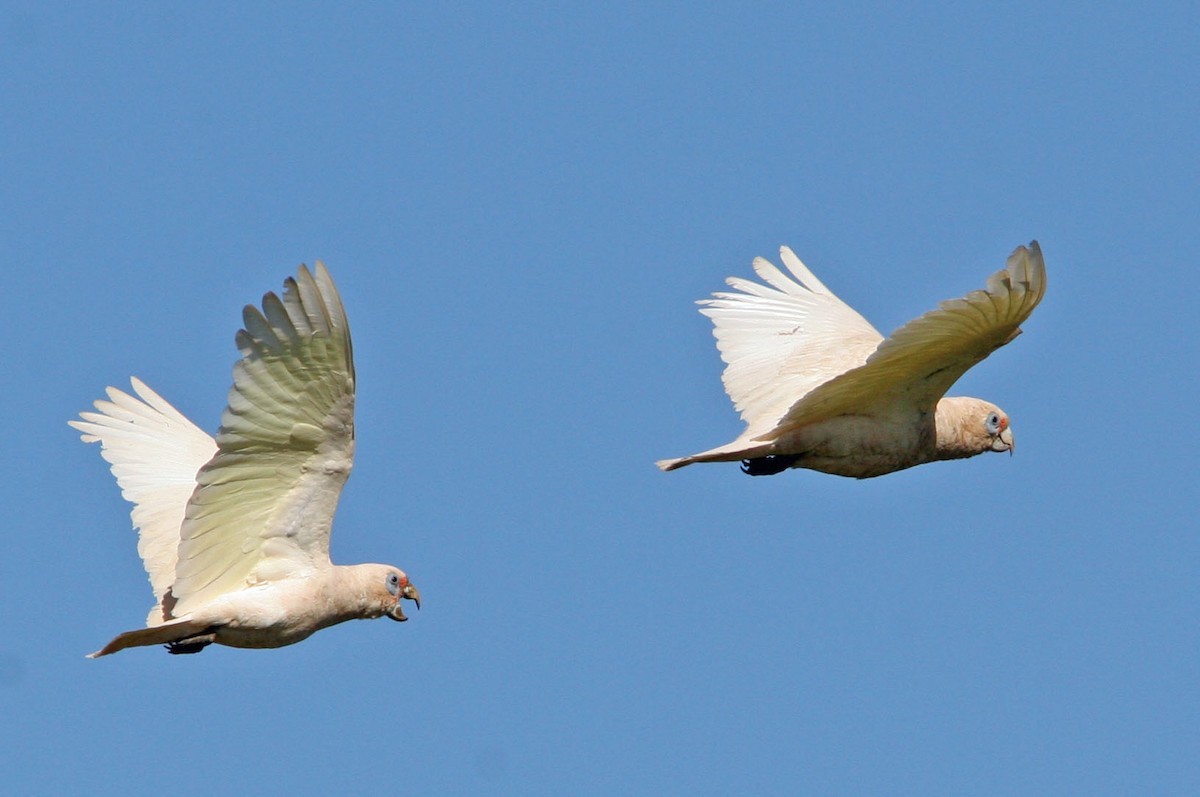Western Corella
A species of White Cockatoos and Corellas Scientific name : Cacatua pastinator Genus : White Cockatoos and Corellas
Western Corella, A species of White Cockatoos and Corellas
Botanical name: Cacatua pastinator
Genus: White Cockatoos and Corellas
Content
Description General Info
 Photo By Don Roberson
Photo By Don Roberson Description
Cacatua pastinator is a white cockatoo with the upper wing entirely white and under surface of the wing pale yellow. It has an erect white crest, blue grey eye skin, crimson pink colouring between the eyes and beak, a small pink patch on the throat, and long pointed bill. Cacatua pastinator lacks sexual dimorphism and the sexes are difficult to distinguish. Determination of the sex of Cacatua pastinator cannot be determined on the basis of eye colour or plumage, observations of pairs have revealed that the males are larger than the females and have a deeper alarm call. Cacatua pastinator is a medium-sized stocky cockatoo with broad rounded wings, a short tail, and a crest which is usually flattened. Muir's Corella (Cacatua pastinator pastinator) adults range in length from 43–48 centimetres (17–19 in) and weigh 560–815 grams (19.8–28.7 oz). The northern subspecies, Butler's Corella (Cacatua pastinator butleri), are a smaller bird with adults 40–48 centimetres (16–19 in) in length and weighing up to 700 grams (25 oz). The bill is a dullish grey white, the legs are dark grey and the upper mandible has a long tip. The underparts are often stained or dirty as a result of feeding on the ground and digging. The flesh of the western corella is described as plump and tender, and suitable for stewing. 
Size
45 cm
Life Expectancy
50 years
Nest Placement
Cavity
Feeding Habits
Western Corella primarily consume seeds, notably wheat grain and native varieties, depending on season. They forage for bulbs and corms with their specialized bill, and larvae form a crucial dietary component, particularly for nestlings. Western Corella feed in open areas and exhibit unique behaviors such as discarding larvae exoskeletons before feeding to young.
Habitat
The habitat of western Corella primarily consists of grassy, open forests and eucalypt woodlands, often found in proximity to watercourses. These birds are also prevalent in adjacent farmlands that feature large trees. While less frequent, their presence is noted within regions of mulga and mallee vegetation. Western Corella thrive in environments that provide a combination of wooded areas and open spaces, which facilitate their feeding and nesting behaviors.
Dite type
Herbivorous
General Info
Feeding Habits
Bird food type
Behavior
Cacatua pastinator are an iconic species of bird in Western Australia. They are often conspicuous in large flocks of up to 700 birds during summer which move around the areas spending days or week in any one location feeding and behaving raucously. The flocks of immature birds and breeding pairs and the foraging occurred up to 10 km from their nest trees. The breeding pairs of tend to be stable but a moderate rate of divorce of about 15% has been observed. Flocks of Corellas are often very noisy and can be heard from a considerable distance. The call of the Corella is a wavering falsetto with distinctly eerie or ghostly tonal qualities. They also have various shrieks and quaverings of squeaky conversational tones. 
Distribution Area
The two separate populations described as subspecies occur in south-west Western Australia. The population occurring in the northern wheatbelt of south-western Australia consist of 5000–10000 birds whilst the population in the far south west of Western Australia consists of approximately 1000 birds. The two isolated populations each consist of one of the identified sub species. Butler's corella (Cacatua pastinator butleri) occurs in the northern and central wheatbelt of Western Australia whilst Muir's corella (Cacatua pastinator pastinator) occurs in the very south-west area of Western Australia. Historical records indicate the species was common at the time of colonisation of Western Australia, and continued to be seen in large flocks during the nineteenth century. The absence of records by the early collector John Gilbert's suggests that this corella was abundant and ubiquitous. The habitat of Cacatua pastinator consists of undulating land with low relief (less than 100 m) with more than 90% of native vegetation cleared for farming of wheat and sheep. The remaining woodland and shrub vegetation communities are restricted to small isolated patches and road reserves. Habitat critical to Cacatua pastinator comprises large eucalypts and other trees (either alive or dead) in forested areas or as lone paddock trees and roadside vegetation, preferred tree species are marri (Corymbia calophylla), jarrah (Eucalyptus marginata), moitch (Eucalyptus rudis), yate (Eucalyptus cornuta) and the paperbark, moonah (Melaleuca preissiana). Cacatua pastinator have displayed three phases of movement patterns within the central wheatbelt of Western Australia, these phases are dependent on the age of the birds. Breeding takes place in spring, following fledging of nestlings the family groups join up with immature flocks and move to summer feeding locations, during the following month the young are weaned and the parents move back to the breeding ground during the January – March period, the juveniles do not return until May or June. Although there is some dispersal to other breeding areas, most individuals display attachment to their natal area with some birds being known to return after being absent for up to five years. 
Species Status
While generally uncommon, it has expanded its range in recent decades, and is therefore listed as of least concern by BirdLife International. However, the nominate subspecies, Muir's corella, is relatively rare, with a population of around 3000 individuals, and is considered to be nationally Vulnerable. 

 Photo By Don Roberson
Photo By Don Roberson